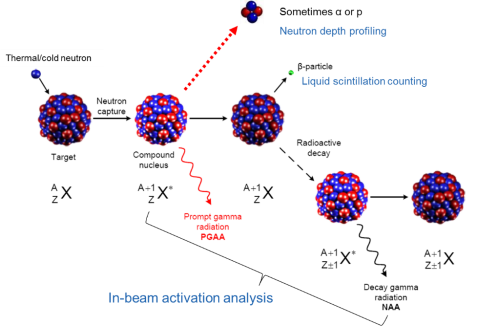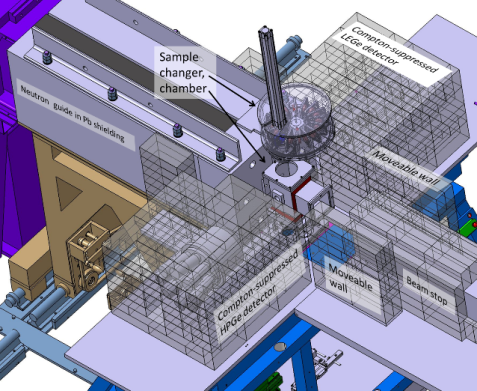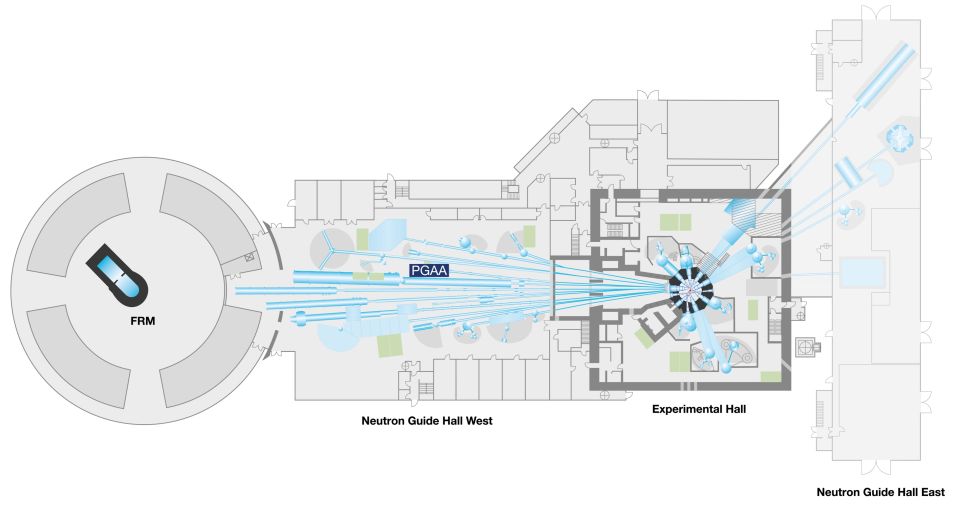MLZ is a cooperation between:
 > Technische Universität München
> Technische Universität München > Helmholtz-Zentrum Hereon
> Helmholtz-Zentrum Hereon
 > Forschungszentrum Jülich
> Forschungszentrum Jülich
MLZ is a member of:
 > LENS
> LENS > ERF-AISBL
> ERF-AISBL
MLZ on social media:

MLZ (eng)
Lichtenbergstr.1
85748 Garching
Elemental Analysis – Nuclear analytical chemistry

Radiations emitted after neutron capture, and the relevant nuclear techniques used for chemical analysis. X represents the element, A is the mass number and Z is the atomic number. © FRM II/TUM
Chemical analysis is one of the most important steps of the sample characterization during which the chemical elements and their quantities (concentrations) are to be determined. Chemical elements are identified by their atomic numbers, i.e. the number of protons in the atomic nucleus, or the number of electrons in the electronic shell. Thus, chemical analysis can be performed in two ways: we excite either the electronic shell or the atomic nucleus to induce radiation characteristic to the element.
At MLZ, we use neutrons to activate the atomic nuclei: there are several nuclear reaction and induced characteristic radiations that can be used for chemical analysis.
Neutrons are ideal for activation. Having no charge, neutrons with any energy can interact with the nuclei. The cross sections are the highest in the thermal to cold energy range.
Whenever a slow (cold or thermal) neutron is captured, a so-called compound nucleus is formed, which is de-excited within 10–14 s with the emission of gamma rays, the so-called prompt gamma radiation. Prompt Gamma Activation Analysis (PGAA) is based on the detection of these gamma photons. In the case of certain light elements, charged particles (protons or alpha particles) are also emitted. Incidentally, the latter are important in Neutron Depth Profiling (NDP) where we use the phenomenon that the energy loss of the detected particle depends on its emission depth. If the nucleus, after reaching the ground state, is stable, the process ends here. However, when it is radioactive, it will emit a beta particle that can also be detected. Certain nuclides/elements can only be detected based on this radiation, phosphorous is one important example, and we are working on the development of the appropriate analytical method. The beta decay is mostly followed by the emission of delayed gamma rays, too, whose detection offers another analytical method, the so-called Neutron Activation Analysis (NAA).
History of the PGAA facility
The original instrument (shielding components, detectors, and electronics) were successfully operated at the Paul Scherrer Institute (PSI, Villingen, Switzerland) 1997–2002. After some modifications and additions, the instrument started its operation at FRM II reactor in 2007. The instrument is now maintained in collaboration with the Institute for Nuclear Physics, University of Cologne.In 2011, 2014 and 2016, further reconstructions took place.
Instrument/ method | Description | Operated by |
|---|---|---|
Prompt gamma activation analysis | TUM/IKP Köln | |
Neutron activation analysis | TUM | |
Neutron Depth Profiling | TUM | |
Fast Neutron-induced Gamma-ray Spectrometry | JCNS |
MLZ is a cooperation between:
 > Technische Universität München
> Technische Universität München > Helmholtz-Zentrum Hereon
> Helmholtz-Zentrum Hereon
 > Forschungszentrum Jülich
> Forschungszentrum Jülich
MLZ is a member of:
 > LENS
> LENS > ERF-AISBL
> ERF-AISBL
MLZ on social media:





